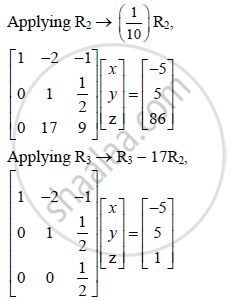Advertisements
Advertisements
Question
The cost of 2 books, 6 notebooks and 3 pens is Rs 40. The cost of 3 books, 4 notebooks and 2 pens is Rs 35, while the cost of 5 books, 7 notebooks and 4 pens is Rs 61. Using this information and matrix method, find the cost of 1 book, 1 notebook and 1 pen separately.
Solution
Let the cost of 1 book, 1 notebook and 1 pen be Rs x, Rs y and Rs z respectively.
According to the given conditions,
2x + 6y + 3z = 40
3x + 4y + 2z = 35
5x + 7y + 4z = 61
These equations can be written in the matrix form as


By equality of matrices,\
x − 2y − z = −5 ….(i)
y + z/2= 5 ….(ii)
z/2 = 1 ….(iii)
From (iii), z = 2
Putting z = 2 in (ii), we get
y + 1 = 5
∴ y = 4
Putting y = 4, z = 2 in (i), we get
x − 8 − 2 = − 5
∴ x = 5
Thus, the cost of 1 book, 1 notebook and 1 pen are 5, 4 and 2 respectively
APPEARS IN
RELATED QUESTIONS
The sum of three numbers is 9. If we multiply third number by 3 and add to the second number, we get 16. By adding the first and the third number and then subtracting twice the second number from this sum, we get 6. Use this information and find the system of linear equations. Hence, find the three numbers using matrices.
Using the properties of determinants, solve the following for x:
`|[x+2,x+6,x-1],[x+6,x-1,x+2],[x-1,x+2,x+6]|=0`
Prove that `|(yz-x^2,zx-y^2,xy-z^2),(zx-y^2,xy-z^2,yz-x^2),(xy-z^2,yz-x^2,zx-y^2)|`is divisible by (x + y + z) and hence find the quotient.
x + y + z + w = 2
x − 2y + 2z + 2w = − 6
2x + y − 2z + 2w = − 5
3x − y + 3z − 3w = − 3
Use elementary column operations \[C_2 \to C_2 - 2 C_1\] in the matrix equation \[\begin{pmatrix}4 & 2 \\ 3 & 3\end{pmatrix} = \begin{pmatrix}1 & 2 \\ 0 & 3\end{pmatrix}\begin{pmatrix}2 & 0 \\ 1 & 1\end{pmatrix}\] .
If three numbers are added, their sum is 2. If two times the second number is subtracted from the sum of the first and third numbers, we get 8, and if three times the first number is added to the sum of the second and third numbers, we get 4. Find the numbers using matrices.
Apply the given elementary transformation on each of the following matrices `[(3, 1, -1),(1, 3, 1),(-1, 1, 3)]`, 3R2 and C2 ↔ C2 – 4C1.
Find the cofactor matrix, of the following matrices : `[(1, 2),(5, -8)]`
Find the cofactor matrix, of the following matrices: `[(5, 8, 7),(-1, -2, 1),(-2, 1, 1)]`
Choose the correct alternative.
If A = `[(2, 5),(1, 3)]`, then A–1 = _______
Fill in the blank :
Order of matrix `[(2, 1, 1),(5, 1, 8)]` is _______
State whether the following is True or False :
Single element matrix is row as well as column matrix.
State whether the following statement is True or False:
After applying elementary transformation R1 – 3R2 on matrix `[(3, -2),(1, 4)]` we get `[(0, -12),(1, 4)]`
Find the inverse of matrix A = `[(1, 0, 1),(0, 2, 3),(1, 2, 1)]` by using elementary row transformations
If A is a 3 × 3 matrix and |A| = 2, then the matrix represented by A (adj A) is equal to.
If AX = B, where A = `[(1, 2, 3), (-1, 1, 2), (1, 2, 4)]` and B = `[(1), (2), (3)]`, then X is equal to ______
If A = `[(1, 1, -1), (1, -2, 1), (2, -1, -3)]`, then (adj A)A = ______
If `[(2, 3), (3, 1)][(x), (y)] = [(-5), (3)]`, then the values of x and y respectively are ______
The inverse of a symmetric matrix is ______.
If a matrix has 28 elements, what are the possible orders it can have? What if it has 13 elements?
Find the values of a and b if A = B, where A = `[("a" + 4, 3"b"),(8, -6)]`, B = `[(2"a" + 2, "b"^2 + 2),(8, "b"^2 - 5"b")]`
Find A, if `[(4),(1),(3)]` A = `[(-4, 8,4),(-1, 2, 1),(-3, 6, 3)]`
If possible, find BA and AB, where A = `[(2, 1, 2),(1, 2, 4)]`, B = `[(4, 1),(2, 3),(1, 2)]`
Solve for x and y: `x[(2),(1)] + y[(3),(5)] + [(-8),(-11)]` = O
If A = `[(1, 5),(7, 12)]` and B `[(9, 1),(7, 8)]`, find a matrix C such that 3A + 5B + 2C is a null matrix.
If P(x) = `[(cosx, sinx),(-sinx, cosx)]`, then show that P(x) . (y) = P(x + y) = P(y) . P(x)
Find x, y, z if A = `[(0, 2y, z),(x, y, -z),(x, -y, z)]` satisfies A′ = A–1.
On using elementary row operation R1 → R1 – 3R2 in the following matrix equation: `[(4, 2),(3, 3)] = [(1, 2),(0, 3)] [(2, 0),(1, 1)]`, we have: ______.
`abs((1,1,1),("e",0,sqrt2),(2,2,2))` is equal to ____________.
If f(x) = `|(1 + sin^2x, cos^2x, 4 sin 2x),(sin^2x, 1 + cos^2x, 4 sin 2x),(sin^2 x, cos^2 x, 1 + 4 sin 2x)|`
What is the maximum value of f(x)?
